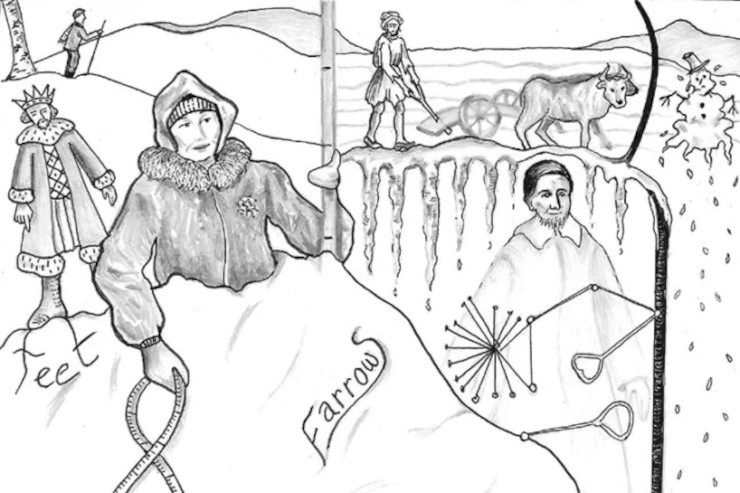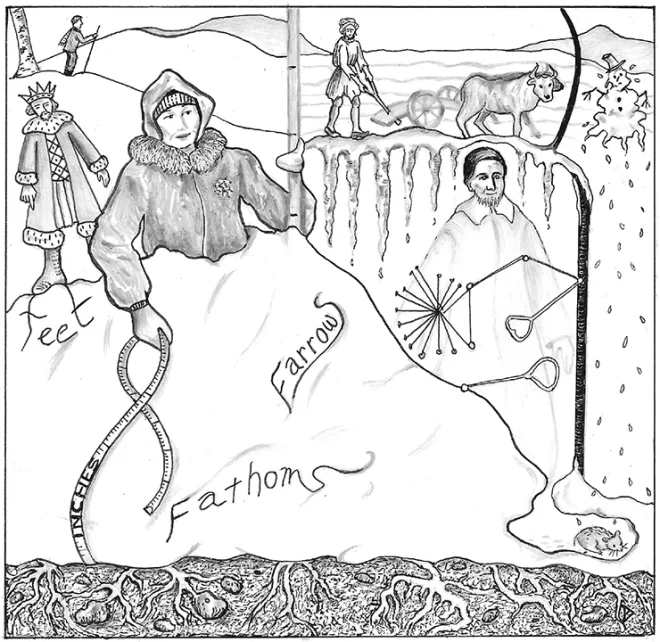
Today I present to you an oddly satisfying history of measurement. But first, flamingos! In the charming city of Madison, Wisconsin–whose official bird is none other than the iconic pink plastic flamingo–snow depths are often measured in terms of flamingos. A half-flamingo snowfall, which leaves a yard’s resident avian friend up to its stomach in powdery white fluffiness, typically measures at about one and a half feet deep; conversely, for those hearty winter storms that bury it up to its little head with nearly three feet of accumulation can only be described as a full-blown “full flamingo” event!
While the pink flamingo is most obviously associated with warm, sunny days and green grassy lawns, Madison’s embrace of this symbol shows how one can adapt to even the coldest of Winter climates. Indeed, in a city that averages over 40 inches of snow per year and often experiences sub-zero temperatures well into the Spring months, the playful and whimsical spirit of the flamingo serves to remind residents of warmer, more tropical days just around the corner.
Have you ever wondered about the history of measuring units? I haven’t, that’s for sure. But today’s story changed my mind. It turns out that the history of measurement traditionally had a lot to do with people planting stuff.
Today’s story, “Feet, Fathoms, and Flamingos” is, surprisingly, not about flamingos. It’s about the history of measurement. And if that sounds boring, don’t worry, it has flamingos and plants in it! Keep reading, you’ll see what I mean!
Enjoy More Gardening Science
This story about the history of measurement comes from our archive that spans over 30 years, and includes more than 130 magazine issues of GreenPrints. Pieces like these that turn stories of gardening science into everyday life lessons always brighten up my day, and I hope this story does for you as well. Enjoy!

Feet, Fathoms, and Flamingos
What are most of our measuring units based on? Gardening! (OK, farming.)
By Becky Rupp
How much snow? If there’s any measure most prone to exaggeration, inaccuracy, and anecdote, it may be depth of snow—possibly only topped by size of fish, which as anyone who is (or knows) a fisherman is aware, can reach gigantic proportions, especially if said fish got away before being hauled into a boat within reach of a tape measure.
The snow-afflicted tend to describe snow depth in terms of what’s been buried in it—porch steps, mailboxes, fences—or sometimes in terms of how much of it comes over the tops of one’s boots, or occasionally in the historical sense as in “Not as much as the year George lost the car.” My grandparents—who lived in our house long before we did—told “Donner-Party”-like stories of years when the snow was so deep that their groceries were delivered via snowmobile through the upstairs bedroom windows.
In Madison, Wisconsin, a city whose official bird is the pink plastic flamingo, snow depth is commonly calculated in flamingos. A half-flamingo snowfall, for example, which buries the average yard bird up to its tummy, is about a foot and a half deep; a full flamingo, which buries it up to its little pink head, measures about three feet.
The National Weather Service, less romantically, routinely reports snow depth in unadorned inches and feet—that is, in United States customary units, which were originally based on British imperial measures. These last, in their inception, were a little scatty: the British imperial foot, according to at least one story, was first standardized in 1100, based on the foot of Henry I, fourth and youngest son of William the Conqueror. The foot was supposedly measured while encased in Henry’s boot, either to preserve the royal dignity or to make it look bigger than it actually was.

The foot, as a unit of measure, has been around a lot longer than Henry. Stonehenge and the Parthenon, according to archaeologists, were laid out in some version of ancient feet. So was Hadrian’s Wall, built by some 15,000 Roman legionnaires across northern Britain in the second century CE with the hope of intimidating the northern barbarians. Roman engineers relied on paces: five feet to the pace, 1,000 paces to the mile, which meant that there were 5,000 feet per Roman mile, a simple and easy-to-multiply system. We’d all be better off if the Brits had stuck with it.
They didn’t; instead they opted for the furlong.
The furlong—originally furrow-long—was the average length of a plowed furrow in an English medieval field, presumably based on the stretch a team of oxen could plow before pausing to take a breather. It’s equal to about 660 feet, which explains our current-day ungainly 5280-foot mile. Queen Elizabeth I —who was better at languages than math—thought it would be nice to have an eight-furlong mile. To this day, every American mile—think of all those helpful highway how-many-miles-to-the-exit signs—harks back to some medieval peasant planting barley.
And then there’s Gunter’s chain. In 1620, English mathematician Edmund Gunter invented a handy surveyor’s tool—a 100-link chain that (plus handles) measured exactly 66 feet, or one-tenth of a furlong. (Gunter was also known for inventing an early version of the slide rule, devising an improved sextant, coining the trigonometric term cosine, and writing a catchy treatise on the crossbow.) Pioneer fences were measured in chains; the modern city block is based on Gunter’s chain—4 chains per block; and the awkward American acre of 43,560 square feet (10 square chains) is, at heart, all the fault of furrows and exhausted medieval oxen.
Measurement, in other words, traditionally had a lot to do with people planting stuff.
Depth—as in huge piles of snow—might more traditionally be measured in fathoms. The original fathom was a measure from the tip of the middle finger on one hand to the tip of the other with arms extended—or about six feet. (Try it.) Commonly it was used in a nautical sense to measure depth of water; when Shakespeare in The Tempest wrote “Full fathom five thy father lies,” he meant 30 feet down.
So—how much snow? There’s more to measuring snow, it turns out, than simply sticking a yardstick into the nearest handy drift. For one thing, you want to avoid measuring snow depth on grass because air caught between the blades makes it look like there’s more snow than there actually is. A flat surface is best—for example, the picnic table that you neglected to drag in last Fall—provided it’s not sitting under a tree or subject to howling winds.
The National Weather Service uses a device called a snow board for their professional snow measurements. This is exactly what it sounds like—a board—set flat on the ground and marked with a couple of handy stakes so that shivering meteorologists can (hopefully) locate it post-storm. (The same clever trick applies here in Vermont so that the fuel truck driver can find our buried propane tank.) Recommended snow-board technique is to measure every six hours, sweeping (or shoveling) the board clean between samples. This prevents too much snow from accumulating, settling, and compacting, which makes it look like there’s less snow than there actually was, which is a big deal if you’re planning to boast about the awfulness of your blizzard.
Not everybody appreciates snow.
Skiers, of course, revel in it, and the more the better; teachers and kids alike get a thrill out of unexpected snow days; and almost everybody loves a white Christmas. On the negative side are treacherous roads and a lot of back-breaking shoveling, plus—face it —the stuff is really cold. “Winter is icumen in,” wrote poet Ezra Pound. “Lhude sing Goddamn.”
But look at it from the garden’s point of view.
A hefty blanket of snow acts as a cozy insulator, protecting buried roots from the worst of freezing temperatures; and snow—traditionally nicknamed the “poor man’s fertilizer”—carries with it a useful dose of nitrogen, an element essential for plant growth. According to one estimate, snow adds as much as 12 pounds of absorbable nitrogen per acre to soil—which may not be a lot as fertilizer goes, but it certainly can’t hurt.

In other words, don’t despair. No matter how frightful the Winter weather, snow—whether if falls on your ground in inches, feet, fathoms, or flamingos—is the beginning of next Spring’s garden.
With a potential crop—measure them!—of truly impressive tomatoes, zucchinis, and pumpkins. ❖
AUTHOR, published originally in 2016, in GreenPrints Issue #118. Illustrated by ILLUSTRATOR

Does this story about the history of measurement stir up any fun facts in you? Leave a comment and share it with us!




Very interesting, thanks for sharing.